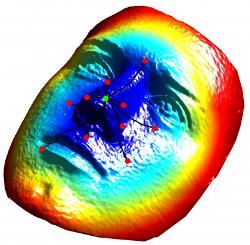Nov 11 2009
University of Miami engineer presents novel methods for 3-D face recognition and for ear and face biometric systems at the 2009 IEEE International Conference on Image Processing in Cairo, Egypt, on Saturday, Nov. 7-Tuesday, Nov. 10
A number of U.S. states now use facial recognition technology when issuing drivers licenses. Similar methods are also used to grant access to buildings and to verify the identities of international travelers. Historically, obtaining accurate results with this type of technology has been a time intensive activity. Now, a researcher from the University of Miami College of Engineering and his collaborators have developed ways to make the technology more efficient while improving accuracy.
 This photo shows how to determine discriminative anatomical point pairings using Adaboost for 3-D face recognition
This photo shows how to determine discriminative anatomical point pairings using Adaboost for 3-D face recognition
Mohamed Abdel-Mottaleb, professor and chair in the UM Department of Electrical and Computer Engineering has developed state-of-the-art systems capable of photographing an image of someone's face and ear and comparing it against pre-stored images of the same person, with 95-100 percent accuracy.
Abdel-Mottaleb presented his findings at the 2009 IEEE International Conference on Image Processing in Cairo, Egypt on Saturday, November 7 - Tuesday, November 10. He describes his research as "satisfying, especially when you know that what you're doing has real-world applications that will benefit people and enhance personal security."
The systems the researchers have designed can use 3-D facial images, or combine 2-D images of the face with 3-D models of the ear, which they construct from a sequence of video frames, to identify people by unique facial features and ear shapes.
In the first method, the researchers use 3-D facial images with over 95 percent recognition rate, in the lab setting. Conventional shape matching methods commonly used in 3-D face recognition are time consuming. Abdel-Mottaleb uses a method that effectively increases computational efficiency while maintaining an acceptable recognition rate. He reduces the number of vertices (distinguishable landmarks of each face) considered when matching 3-D facial data, by automatically selecting the most discriminative facial regions. These automatically selected landmarks were found to be primarily within the regions of the nose, eye brows, mouth, and chin.
The second method called "Multi-Modal Ear and Face Modeling and Recognition" obtains a set of facial landmarks from frontal facial images and combines this data with a 3-D ear recognition component-- a much more difficult identification process given the technique's sensitivity to lighting conditions.
Fusing the scores of these two modalities, the researchers achieved an identification rate of 100 percent in the lab. "No single approach can give you 100 percent accuracy," Abdel-Mottaleb says. "One way to increase the accuracy is to use different biometrics and then combine them."
These high-tech identification tools help fight crime, and enforce border security. In the future, the researchers hope to expand their techniques to faces demonstrating facial expressions and to recognize faces using only profile images.